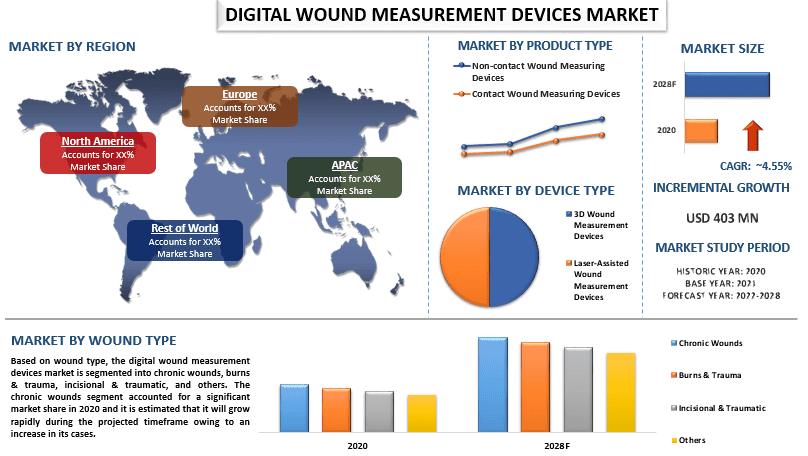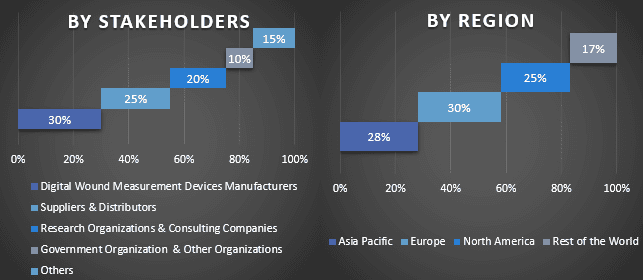- Home
- About Us
- Industry
- Services
- Reading
- Contact Us
Digital Wound Measurement Devices Market: Current Analysis and Forecast (2022-2028)
Emphasis on Product Type (Non-contact Wound Measuring Devices and Contact Wound Measuring Devices); Device Type (3D Wound Measurement Devices and Laser-Assisted Wound Measurement Devices); Wound Type (Chronic Wounds, Burns & Trauma, Incisional & Traumatic, and Others); End User (Hospitals, Clinics, Community Centers, and Others) and Region/Country

Global Digital Wound Measurement Devices Market is expected to grow at a significant rate of around 4.55% during the forecast period. To monitor chronic wounds and administer the correct medication dose to hasten the healing process, digital wound measurement devices are employed. If neglected, chronic wounds can lead to amputations and potentially fatal infections. Digital wound measurement tools make it possible to give customized treatments after a 2D or 3D evaluation of the infection and inflammation. Therefore, it is also projected that the number of injuries or traumatic wounds as well as the rising occurrences of chronic disease-associated wounds, such as those in diabetic patients, will propel the market. For instance, according to the IDF Diabetes Atlas Ninth edition, 2019, 1 out of 5 people who are above 65 years old have diabetes and 1 out of 2 (232 million) people were suffering from diabetes but were undiagnosed. Furthermore, the growing cases of chronic diseases-associated wounds, rising traumatic injuries such as falls, accidents, and burns, increase in the aging population, increasing awareness of proper wound care management, rising capital for wound care research, and technological developments in wound care products are also some of the factors that are positively influencing the digital wound measurement devices market across the globe.
Parable Health, ARANZ Medical Limited, eKare, Inc., WoundMatrix, Inc., Kent Imaging Inc., Integra LifeSciences, Smith & Nephew plc., WoundRight Technologies, LLC, WoundVision, LLC, Hitachi Healthcare Americas are some of the key players in the market. Several M&As along with partnerships have been undertaken by these players to facilitate customers with drugs.
Insights Presented in the Report
“Amongst product type, non-contact wound measuring devices category to witness higher CAGR during the forecast period”
Based on product type, the digital wound measurement devices market is bifurcated into non-contact wound measuring devices and contact wound measuring devices. The non-contact wound measuring devices segment accounted for a significant market share in 2020 and it is estimated that it will grow rapidly during the projected timeframe owing to its advantages over its counter devices. Moreover, non-contact wound measuring devices take precise pictures of wounds for record-keeping, which in turn is a major factor contributing to the growth of this segment.
“Amongst device type, 3D wound measurement devices to hold a significant share in the market in 2020”
Based on device type, the digital wound measurement devices market is bifurcated into 3D wound measurement devices and laser-assisted wound measurement devices. The 3D wound measurement devices segment grabbed a significant market share in 2020. The growth of this segment can be attributed to the rising technological developments in wound care products and the increasing awareness of proper wound care management.
“Amongst wound type, chronic wounds to hold a significant share in the market in 2020”
Based on wound type, the market is segmented into chronic wounds, burns & trauma, and incisional & traumatic. Among these, chronic wounds to hold a significant share of the market in 2020. This is mainly due to the rising cases of chronic wounds such as diabetic foot ulcers, and pressure ulcers among others.
“Amongst end user, hospital to hold a significant share in the market in 2020”
Based on end user, the market is segmented into hospitals, clinics, community centers, and others. Among these, the hospital to hold a significant share of the market in 2020. This is mainly due to the increasing preference of patients to avail treatment in hospitals. Also, the tendency of consumers to visit hospitals for safe and authorized treatment will drive the growth of this segment.
“North America to hold a significant share in the market”
For a better understanding of the market adoption of the digital wound measurement devices industry, the market is analyzed based on its worldwide presence in the countries such as North America (U.S., Canada, and the Rest of North America), Europe (Germany, U.K., France, Spain, Italy, Rest of Europe), Asia-Pacific (China, Japan, India, Rest of Asia-Pacific), Rest of World. North America is anticipated to grow at a substantial CAGR during the forecast period. According to the National Burn Repository, 2019, of the American Burn Association (ABA), flame burns continue to account for the bulk of injuries in the US (43%) followed by scalds (34%), contact (9%), electrical burn injuries (4%), chemical burn injuries (3%) and miscellaneous (7%). Therefore, the region’s market expansion is influenced by the growing incidence of cases of wounds.
Reasons to buy this report:
- The study includes market sizing and forecasting analysis validated by authenticated key industry experts.
- The report presents a quick review of overall industry performance at one glance.
- The report covers an in-depth analysis of prominent industry peers with a primary focus on key business financials, product portfolio, expansion strategies, and recent developments.
- Detailed examination of drivers, restraints, key trends, and opportunities prevailing in the industry.
- The study comprehensively covers the market across different segments.
- Deep dive regional level analysis of the industry.
Customization Options:
The global digital wound measurement devices market can further be customized as per the requirement or any other market segment. Besides this, UMI understands that you may have your own business needs, hence feel free to connect with us to get a report that completely suits your requirements.
Table of Content
Research Methodology for the Digital Wound Measurement Devices Market Analysis (2022-2028)
Analyzing the historical market, estimating the current market, and forecasting the future market of the global digital wound measurement devices market were the three major steps undertaken to create and analyze the adoption of digital wound measurement devices in major regions globally. Exhaustive secondary research was conducted to collect the historical market numbers and estimate the current market size. Secondly, to validate these insights, numerous findings and assumptions were taken into consideration. Moreover, exhaustive primary interviews were also conducted, with industry experts across the value chain of the global digital wound measurement devices market. Post assumption and validation of market numbers through primary interviews, we employed a top-down/bottom-up approach to forecasting the complete market size. Thereafter, market breakdown and data triangulation methods were adopted to estimate and analyze the market size of segments and sub-segments of the industry pertains to. Detailed methodology is explained below:
Analysis of Historical Market Size
Step 1: In-Depth Study of Secondary Sources:
Detail secondary study was conducted to obtain the historical market size of the digital wound measurement devices market through company internal sources such as annual reports & financial statements, performance presentations, press releases, etc., and external sources including journals, news & articles, government publications, competitor publications, sector reports, third-party database, and other credible publications.
Step 2: Market Segmentation:
After obtaining the historical market size of the digital wound measurement devices market, we conducted a detailed secondary analysis to gather historical market insights and share for different segments & sub-segments for major regions. Major segments are included in the report as product type, device type, wound type, and end user. Further country-level analyses were conducted to evaluate the overall adoption of testing models in that region.
Step 3: Factor Analysis:
After acquiring the historical market size of different segments and sub-segments, we conducted a detailed factor analysis to estimate the current market size of the digital wound measurement devices market. Further, we conducted factor analysis using dependent and independent variables such as various. A thorough analysis of product type, device type, wound type and end user of digital wound measurement devices was conducted for demand and supply-side scenarios considering top partnerships, mergers and acquisitions, business expansion, and product launches in the digital wound measurement devices market sector across the globe.
Current Market Size Estimate & Forecast
Current Market Sizing: Based on actionable insights from the above 3 steps, we arrived at the current market size, key players in the global digital wound measurement devices market, and market shares of the segments. All the required percentage shares split, and market breakdowns were determined using the above-mentioned secondary approach and were verified through primary interviews.
Estimation & Forecasting: For market estimation and forecast, weights were assigned to different factors including drivers & trends, restraints, and opportunities available for the stakeholders. After analyzing these factors, relevant forecasting techniques i.e., the top-down/bottom-up approach were applied to arrive at the market forecast for 2028 for different segments and sub-segments across the major markets globally. The research methodology adopted to estimate the market size encompasses:
- The industry’s market size, in terms of revenue (USD) and the adoption rate of the digital wound measurement devices market across the major markets domestically
- All percentage shares, splits, and breakdowns of market segments and sub-segments
- Key players in the global digital wound measurement devices market in terms of products offered. Also, the growth strategies adopted by these players to compete in the fast-growing market
Market Size and Share Validation
Primary Research: In-depth interviews were conducted with the Key Opinion Leaders (KOLs) including Top Level Executives (CXO/VPs, Sales Head, Marketing Head, Operational Head, Regional Head, Country Head, etc.) across major regions. Primary research findings were then summarized, and statistical analysis was performed to prove the stated hypothesis. Inputs from primary research were consolidated with secondary findings, hence turning information into actionable insights.
Split of Primary Participants in Different Regions

Market Engineering
The data triangulation technique was employed to complete the overall market estimation and to arrive at precise statistical numbers for each segment and sub-segment of the global digital wound measurement devices market. Data was split into several segments & sub-segments post studying various parameters and trends in the areas of product type, device type, wound type, and end user in the global digital wound measurement devices market.
The main objective of the Global Digital Wound Measurement Devices Market Study
The current & future market trends of the global digital wound measurement devices market were pinpointed in the study. Investors can gain strategic insights to base their discretion for investments on the qualitative and quantitative analysis performed in the study. Current and future market trends determined the overall attractiveness of the market at a regional level, providing a platform for the industrial participant to exploit the untapped market to benefit from a first-mover advantage. Other quantitative goals of the studies include:
- Analyze the current and forecast market size of the digital wound measurement devices market in terms of value (USD). Also, analyze the current and forecast market size of different segments and sub-segments
- Segments in the study include areas of product type, device type, wound type and end user.
- Define and analysis of the regulatory framework for the digital wound measurement devices
- Analyze the value chain involved with the presence of various intermediaries, along with analyzing customer and competitor behaviors of the industry.
- Analyze the current and forecast market size of the digital wound measurement devices market for the major region.
- Major countries of regions studied in the report include Asia Pacific, Europe, North America, and the Rest of the World.
- Company profiles of the digital wound measurement devices market and the growth strategies adopted by the market players to sustain in the fast-growing market
- Deep dive regional level analysis of the industry
Related Reports
Customers who bought this item also bought










